Review: LG V20 for AT&T
Nov 4, 2016, 3:00 PM by Eric M. Zeman
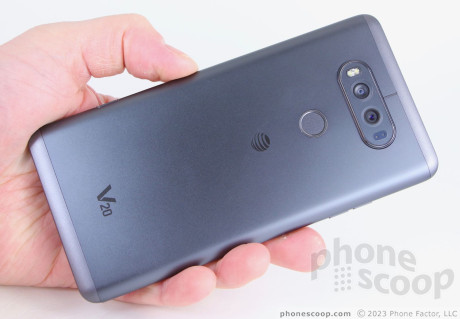
The V20 is LG's biggest, most advanced Android smartphone to-date. The V20 boasts three cameras, a quad HD screen, superior audio capture, and the interesting Second Screen display. It's one of the first few phones to ship with Android 7 Nougat and comes with a staggering amount of software to manage. Is LG's behemoth the right camera-focused flagship for you? Find out in Phonescoop's full report.
Hardware
Is It Your Type?
The LG V20, with its dual cameras and huge screen, targets the photo and phablet lovers of the world. It's a high-end handset that packs incredible performance in a metal-skinned slab. If you can stomach the astronomical price tag, the LG V20 is a worthy alternative to flagships from Google and Apple.
Body
The LG V20 drops the over-wrought design of last year's V10 for a simpler, more polished look. LG clearly took the basic template from its own G5 handset (minus the modularity, of course) and applied it to the V-series. The result is a gigantic metal handset with rather simple lines and a surprising amount of flexibility.
Last year's V10 included polished metal rails along the sides, and a toughened polycarbonate rear panel. It was strong as hell, though rather chaotic as far as looks were concerned. The V20 adopts a more refined approach in its stylings and is more cohesive as a result. I appreciate the cleaner lines. Some might say the V20 betrays the V10's personality in the process; I value the refinement. True, it's another metal-and-glass handset where there's little room for design innovation these days, and yet the V20 somehow manages to avoid boring me-too looks.
The V20 is one of the biggest and heaviest phones I've reviewed this year. It's a bit bigger than both the Google Pixel XL and Apple iPhone 7 Plus. There's no doubt the V20 is a two-handed phone. My thumb can reach only about 40% of the screen comfortably. I have to perform some serious hand acrobatics to reach the top of the screen, which places the phone in dire jeopardy of slipping from my grasp. The phone is hella-wide, making it hard to grip tightly. Thank goodness LG kept the thickness to 7.6mm. The V20 is slim enough to drop into your loose pockets, but you'll have to jam it down if you have tight pants.
LG settled on a mix of materials in crafting the V20. The build quality is very good, but just short of excellent. I have no problem with the huge glass panel that forms most of the front surface, nor the aluminum shell that covers the rear and helps form the side edges. These components are fine. I do, however, dislike the plastic caps that form the V20's chin and forehead. The plastic allows wireless signals to pass through, so I understand their purpose. Sadly, the seams between the plastic caps and metal rear panel are uneven and create an edge that catches your skin. I noticed a similar issue with the LG G5 earlier this year. That issue aside, the V20 is otherwise a solid phone that feels every bit as expensive as it is.
The V20's face is dominated by the display panel. The black glass covers the bulk of the front, with the slim plastic caps providing contrasting bookends. The caps are both angled away from the display. The user-facing camera module is plainly visible in the glass. The Second Screen remains illuminated even with the main display is off, so the date, time, and battery indicators are always visible in the top right of the V20's face. LG's logo is practically invisible below the display. There are no buttons on the front, as the V20 uses software controls.
LG separated the volume toggle into two distinct buttons and stuck them on the left edge of the phone. The buttons are a little small for my tastes. Travel and feedback are decent, but not the best. You might be fooled into thinking the lone button on the right edge of the phone is a dedicated camera key. It's not; instead, this button releases the rear aluminum panel. The button is spring-loaded and works well — just don't press it when you're trying to take a picture. The top edge houses an IR port and microphone, while the bottom edge holds the speaker, USB-C port, and stereo headphone jack.
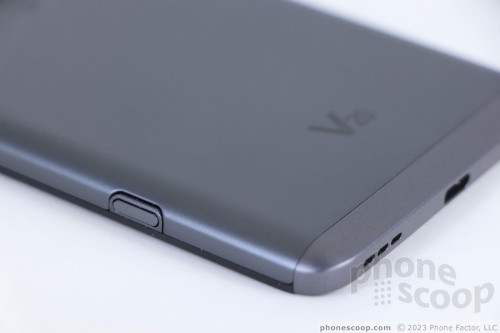
Like many LG handsets, the screen lock button is positioned on the rear surface of the phone. In this case it doubles as a fingerprint reader. It's a small circle and is indented just a bit. I didn't have any trouble locating or using the button by feel. Travel and feedback are good. The monstrously big camera module is positioned above the screen lock button. The module measures 1.68 inches wide and juts out from the rear surface like a tiny island. It has a chrome rim that makes it stand out (even more) visually. The module contains two separate cameras as well as a dual-LED flash and the focusing array. It's big.
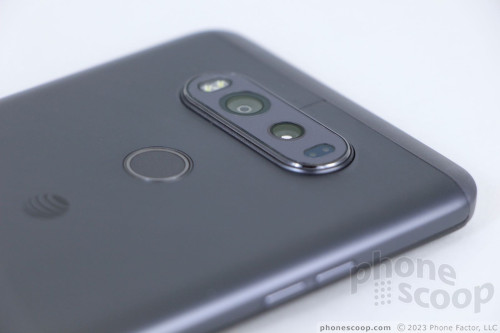
Amazingly, LG decided to give the V20 a removable rear panel. A press of the side button pops the latches holding the panel in place. It's quite easy to remove and snap back into place. By itself, the rear, metal panel is quite rigid. The V20 boasts a removable battery, too, a feature that is becoming quite rare for premium handsets. The phone also includes a slot for memory cards. The slot is stacked atop the SIM card slot. You can swap memory cards without pulling the battery, but not SIM cards.
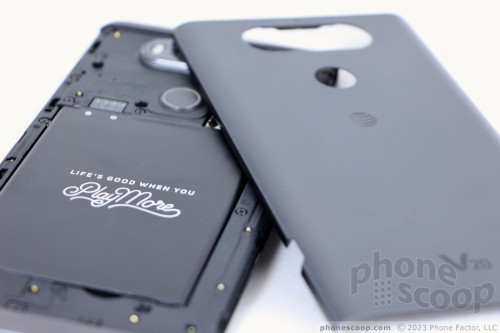
The V20 is not water resistant.
The LG V20 is a very, very good piece of hardware that many people will surely enjoy. It is ridiculously big, but the design works, and features such as the removable battery and memory card support make up for the small inconsistencies in build quality.
Screen
The primary screen measures 5.7 inches across the diagonal and boasts quad HD (2560 by 1440 pixel) resolution. This is as big and as pixel-rich as displays get at the moment. As usual, LG used an LCD panel, and it looks amazing. The screen's large dimensions don't diminish the huge pixel count; you won't see any individual pixels anywhere. Colors are accurate and viewing angles are excellent. The screen was usable outdoors under direct sunlight even with brightness set as low as 50%. It's truly a fine, competitive display. Like many high-end devices, the screen includes a blue-light setting that will kick in late at night to reduce eye strain.
The V20 just barely fit into my Google Cardboard viewer, but 360-degree photos and other content looked very good. High resolution displays like this are critical for a good VR experience.
The second screen at the top is 2.1 inches across with 1040 by 160 pixels. I found it rather hard to see outdoors, but it's bright enough for easy use indoors. I wish you could adjust the second screen's brightness independently from the main display, but you cannot. The resolution is fine for such a small display and the small icons and text it displayed looked clean and sharp.
Signal
LG sent me the AT&T variant of the V20, though variants are available to all major carriers. The V20 performed well enough in and around New York City, but it fell a little short when compared to some other AT&T phones I've tested recently. The radio always remained attached to LTE and never dipped to 3G, even in poor coverage areas. Phone call connectivity was the most obvious shortcoming. The V20 was prone to missing calls and dropping calls in weak coverage areas, something most competitors have managed to avoid lately. Data speeds were generally very good no matter the signal conditions, though not the best I've seen. The V20 handled browsing media-rich social networks with no problem and didn't give me any trouble streaming music or video over LTE.
The V20 is one of the first phones to include support for LTE Band 66, a huge amalgamation of AWS-1, AWS-3, and AWS-4 spectrum blocks. Right now, T-Mobile is the only carrier offering some service in Band 66. AT&T and Verizon own spectrum in these blocks, but have yet to deploy it. Bottom line: people who buy the T-Mo variant of the V20 may see faster data performance.
Sound
LG made a bang-up voice phone in the V20. Voice calls are consistently loud and clear. Callers often sounded like they were standing in the same room. The earpiece pushes out loud, punchy sound with no distortion, making the device usable in even the noisiest environments. You can likely get away with setting the volume at about 60% most of the time. People I spoke to through the V20 said I sounded very good. The V20's vocal clarity outperforms most other handsets I've tested on AT&T lately.
The speakerphone delivers plenty of volume while also keeping distortion to a minimum. The speakerphone can easily fill an entire room with sound and it's a fine companion should you need to make a call from a moving car.
Ringers and alerts can deliver enough sound to make anyone jump out of their skin. The vibrate alert is good, too. Moreover, LG's software allows you to dial in the strength of the vibration alert for different notifications, such as calls or texts. There are also five pre-loaded vibration patterns, and you can record your own. That's cool.
It's worth adding that the V20 includes a high-quality DAC for wired music listening. It puts out very clear, powerful sound when plugged directly into a speaker or stereo system. I tested the V20 with several small speakers, my home theater, and a large PA system. There's no doubt wired sound performance is excellent, and dramatically superior to Bluetooth music playback.
Battery
The V20 has a 3,200 mAh battery, which is average for this class of device. The phone easily delivered a full waking day of power; it lasted from breakfast to bedtime consistently with some power to spare. I kept all the radios on, and left the screen brightness set at 50% with the "auto-brightness" tool engaged. I was not able to kill the battery entirely, not once, while I tested the V20.
Part of the reasoning behind the Second Screen is to help save battery power. The idea is you can glean the time, date, and basic notifications without ever turning on the power-sucking main display. The Second Screen is certainly helpful, but it's unclear if or how much it really helped the battery life in our testing.
LG gave the phone several tools to help manage battery life. To start, it has the basic Android power saver mode, which kicks on when the battery reaches 15%. When turned on, this automatically dims the screen, reduces processor output, and cancels vibrate alerts. The V20 also has a setting that specifically reduces the processor power given to games. Thanks to decent battery life, I didn't need these tools while I reviewed the phone.
Lasty, the V20 supports Quick Charge 3.0 through its USB-C port. Thanks to the included fast charger, the V20 will power up quickly when needed. It doesn't support wireless charging.
Bluetooth, GPS, NFC, WiFi
The V20's secondary radios all functioned properly. Bluetooth was a cinch to use and the NFC radio helped me pair the V20 with a wide array of Bluetooth accessories. I used the V20 for several calls via my car's hands-free system and they sounded very good. Music had a rich sound when passed through a good Bluetooth speaker, but I've heard better.
You can use the NFC radio for mobile payments via Google's Android Pay service if you want. LG is still working on its own branded mobile payment service, which is not expected to debut until next year.
Google Maps and the V20's GPS radio were bosom buddies. The phone located me within seconds and was accurate to about 10 feet. That's excellent. Real-time navigation between points worked flawlessly.
The WiFi worked just fine.
Software
Lock Screen
The V20 carries over the V10's Second Screen functionality with no updates or improvements. That means it's still more of a gimmick than truly necessary.
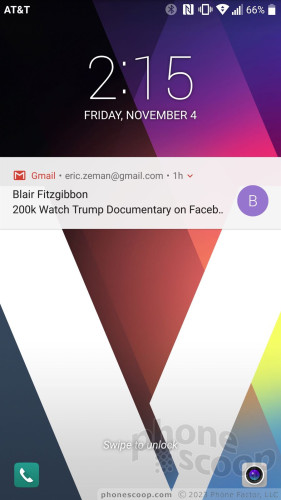
When the phone is locked, the Second Screen always shows the time, date, and battery percentage, but not signal strength. When you receive a notification (message, email, Facebook, etc,) a corresponding icon pops up within the Second Screen. In other words, you can pretty much always read the time or see your basic notifications. But the text and icons are so small, they are hard to see from more than an arm's length away.
If you swipe the Second Screen while the display is off, you'll find shortcuts to the camera, flashlight, WiFi radio, and silent mode. If you tap the Second Screen, it wakes the device and loads the full lock screen where you can better read the clock and your alerts. The full lock screen behaves just like it does on any other Android phone. Notifications pile up below the clock and can be dismissed one at a time or en masse.
You can customize the lock screen a bit. First, you can set which shortcuts appear at the bottom, as well as where the clock appears on the screen. You can also adjust the swiping animation and choose whether or not to display the weather.
The V20 includes LG's KnockOn and Knock Code. Double-tap the display to wake the lock screen. This is most helpful when the phone is sitting on a table or desk, although it's a little redundant since a single tap of the Second Screen has the same effect. KnockCode is an optional security tool that unlocks the phone through a custom pattern of taps on the screen. It's a moot tool, too, given the V20's fingerprint sensor. (But hey, options!)
The V20's fingerprint reader is quick and reliable. It takes only a few moments to set up several fingerprints and I found the reader was consistently the fastest way to unlock the phone. The reader works with just a light touch; you don't have to press the actual button. Beyond unlocking the phone, the fingerprint reader can be used to secure individual photo galleries and QuickMemo files, but not apps or folders.
Home Screen
The V20 is one of the very first phones to ship with Android 7.0 Nougat — not that you'd know, thanks to the ridiculously heavy interface layer added by LG.
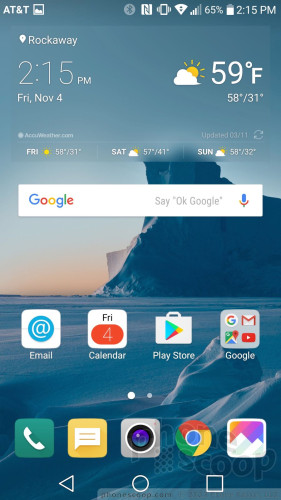
The V20 ships with three different versions of the LG home screen, commonly referred to as a "launcher." Out of the box, the default launcher doesn't include the app drawer. This means users don't have access to a central repository for apps; instead, all the apps are bundled together in folders on the home screens. This gets clutter-y for my taste. You may elect to choose a different home screen experience that includes the app drawer (literally called Launcher + App Drawer). The third home screen experience is LG's EasyHome, which dumbs down the interface for novice users.
There are just two home screen panels active when you first boot the V20. The main screen holds a couple of widgets, several apps/folders, and the dock at the bottom. The second screen is populated with folders containing all the remaining apps. As per usual, the V20 supports multiple home screen panels, widgets, and shortcuts in any configuration you might prefer.
The device allows you to switch up wallpapers and other behaviors with ease. I like that apps can be arranged in various grid configurations (4x4, 4x5, 5x5) to allow for more effective use of the screen's real estate, and, using menu options, you can elect to hide apps you know you won't use often, as well as bring them back when needed. You can control behaviors such as fonts, font size, button arrangement, screen effects, and so on.
The Second Screen doesn't add much value to the home screen experience. The notifications that appear on the Second Screen when the display is off have vanished. Instead, you can swipe between four panels on the Second Screen: your name (What? Who cares to see that?), the radio shortcuts, and two panels of app shortcuts. You can't choose which shortcuts appear. Shortcuts to the camera and settings menu are alway available in the Second Screen, while the others change to reflect your most recently-used apps. The lack of consistency prevents you from developing any muscle memory, which makes them far less useful.
LG didn't mess with the Quick Settings panel too much. It includes five toggles across the top, as well as a slide to control screen brightness. You can customize which toggles appear in the Quick Settings screen and swipe the toggles to see more. The panel also allows you to access, act on, and dismiss notifications.
The main settings tools are broken down into several tabs by default, but you can adjust it so they appear on a single screen. It's rather dense and not that easy to use. Moreover, you lose the easily-gleaned and helpful data that's baked into the stock version of Nougat. For example, in stock Nougat the settings screen shows you how much battery percentage is left, how much RAM or storage you're using, and how many apps you have installed, without digging down into sub-menus. That's all gone in LG's user interface. Boo.
The V20 includes a separate Google Search tool called In Apps. It is specifically meant to help you find content that's hiding within applications on the phone. It can scan emails, messages, maps, photos, your music/video content and more to find specific items. It's nice to have all the results compiled in a single app. This functionality is also built into the main Google Search bar, but the In App results are hidden off screen. This tool is best used when you know you have a specific piece of information on your phone (such as an address) and can't remember the specific app that info is in.
With a Snapdragon 820 and 4 GB of RAM under the hood, the V20 is a very, very fast phone. It does everything in short order. I couldn't find anything to tax the V20 while I used it. Games ran smoothly and VR content presented with no trouble.
Camera
The V20 is all about the camera experience. The V20 doesn't have a physical camera button, but you can launch it from the lock screen or with a quick double press of the volume-down button.
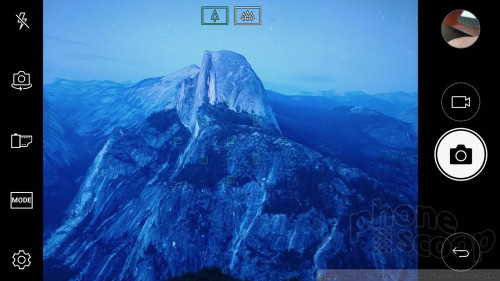
Where the V10 had two user-facing cameras and one rear-facing camera, the V20 adopts the G5's setup and instead has one user-facing camera and two rear-facing cameras. The main sensor on the back captures 16-megapixel images with a 75-degree, normal field of view. The secondary sensor on the back captures 8-megapixel images with a 135-degree, wide-angle field of view. The front-facing sensor captures 8-megapixel images. A toggle appears on the top of the camera app that allows you to jump from the regular-angle camera to the wide-angle camera any time, no matter which shooting mode you're in. Like the iPhone 7 Plus, the V20 allows you to zoom seamlessly from one camera to the other.
The camera interface is a really busy place. Starting from far left, the Second Screen contains three shortcuts to auto (default), manual photo, and manual video. A second batch of options runs down the left side of the main screen and includes flash controls, user-facing camera, film effects, shooting modes, and settings. None of these buttons cannot be customized.
There is a decent selection of shooting modes, including auto, popout, multiview, snap, panorama, slo-mo, and time-lapse.
Pop-out mode creates a picture-within-a-picture effect. In other words, you have a smaller box in the middle of the frame with the subject, and larger box around the outside to which you can add effects (blur, fisheye distortion, etc.) to make the central image pop.
The multiview mode lets you shoot pictures with both rear cameras and the front camera at the same time so you can include yourself in a three-panel montage. This was carried over from the V10 and can be fun. There are several different panel configurations and you can arrange them however you wish.
The snap shooting mode lets you assemble video clips into a 60-second story. You can shoot with 1, 2, or 3 panels in a variety of configurations. A quick tap of the shutter button records a 3-second segment. You can piece together up to 20 of the 3-second clips, or press-and-hold the shutter button to record longer clips up to 60 seconds long. It takes some practice to use effectively.
These three shooting modes are relatively easy to master. The pano, slo-mo, and time-lapse functions work as expected.
Manual mode, available from the Second Screen, is for knowledgeable users who want to be creative. As the name implies, you have full control over everything: white balance, focus, brightness, ISO, and shutter speed. Shutter speed can be set as long as 30 seconds, (for dramatic and/or creative night shots.) You can also set the auto-exposure to lock. Each option has its own slider that lets you, for example, alter the focal point between close and far. As you do this, the screen changes to provide a preview of how the resulting image might look. It gives you some neat insight into how each individual part of the exposure process may affect the final result. Manual mode for video is essentially the same thing. These shooting modes will likely be overwhelming for novice users.
LG buried a simple shooting mode deep in the settings menu. Simple mode is exactly that. It offers no controls. None at all. Tap the screen to take a picture. Swipe the screen to swap between front and rear cameras. You can also toggle between normal and wide angle, but that's it.
The camera settings menu is pretty straightforward. It allows you to adjust image and video resolution, as well as turn on/off geo-tagging, the timer, the grid, and image stabilization. Looking for HDR? It's buried in the settings menu, too. You can set it to on, auto, or off. I wish the HDR tool was accessible from the main viewfinder.
The user-facing camera includes a number of its own tools, including a screen flash, smile capture, gesture shot (make a fist to snap a photo), and beautification filters.
The V20's camera software is extraordinarily quick to focus and snap photos. It's a powerful app that performs well. I wish it were less overwhelming.
Photos/Video
The V20 takes very good photos. Whether you're snapping artistic cityscapes or run-of-the-mill selfies, most people will be happy with their pictures.
In general, basics such as focus, exposure, and color are all good. The main 16-mp camera sensor produces consistently good results. If all you do is take regular shots in the auto mode, you'll be very pleased with the results.
LG appears to have solved the color and exposure issues I saw on the G5's wide-angle camera, as the V20's secondary 8-mp sensor produces solid results, too. The wide-angle camera does, however, introduce obvious optical distortion when you're too close to subjects.
The front 8-mp camera takes great selfies. I recommend you take advantage of the selfie light and go easy with the beautification tool for the best results.
The phone can record video up to 4K. Video stabilization is only available when shooting full HD. I was very pleased with the video results, both 4K and full HD, which were consistently good in terms of exposure, focus, and color.
Of note, the V20 has incredible sound-recording capabilities. It can capture high-definition stereo that sounds lifelike when played back over good equipment.
When compared to competing devices, the V20 certainly holds its own. The camera is absolutely on par with the Galaxy S7, iPhone 7, and Pixel XL. However I do feel like the V20 requires more effort to get the same results that are so easy to accomplish with the iPhone and Pixel.
You can definitely rely on the V20 to serve as your main imaging and video device.
LG Stuff
LG's ever-present QuickMemo tool is on board. It's accessible via the Second Screen and the Quick Settings panel. As always, it takes a screenshot and then opens a basic editor so you can annotate the screenshot and share it with others. It works fine.
QuickMemo
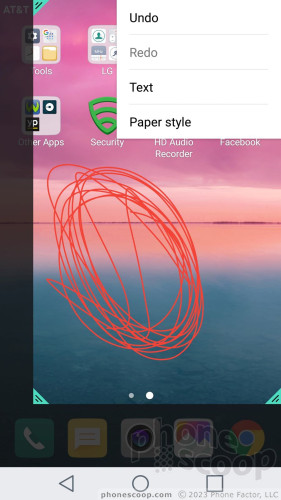
QSlide apps are still around, too. Certain applications, including the phone, browser, calculator, notepad, and others, can be shrunk down to smaller sizes for multitasking. You can drop several QSlide apps on the home screen and quickly bounce between them. I've always liked that you can control the transparency of QSlide apps.
QSlide
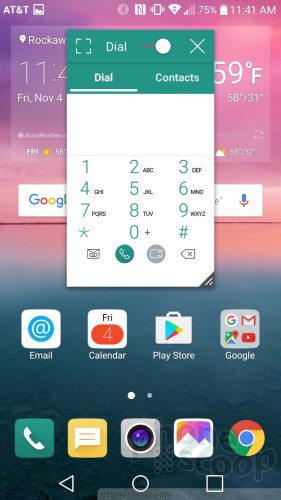
Split-screen multitasking is still around. LG has offered it on its big-screened phones for several years. It's hard to tell if LG is using its own split-screen software or the underlying Nougat-based split-screen software. Whichever it is, the multi-tasking tool is easy to use.
The V20 has an infrared emitter and LG's feature-rich TV remote application. It takes but a moment to configure the app to work with your TV and other home theater equipment. I wish phones more consistently offered TV remote functionality. LG's is among the best available.
LG's Health app is as powerful as ever. It includes beginning and advanced modes to cater to individual needs. LG suggests new users start with the beginner toolset and move to the advanced tools once they've reached a certain level of health and fitness. If you're interested in doing things like tracking steps and diet, that's easy to do with LG Health. It handles walking, running, climbing and cycling and provides an overview of your progress. Too bad it doesn't share data with Google Fit.
LG Health
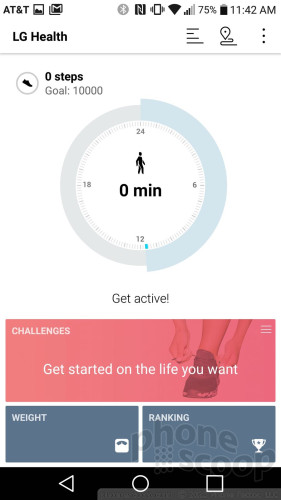
Last, LG added a highly-powerful sound record app to the V20. It makes use of the multiple microphones to record even high-intensity sound, such as concerts. The user interface is straightforward and easy to figure out. I'd say the best way to use this tool is for recording your guitar jam sessions or your kids' school concert — if you're looking for audio only.
AT&T Stuff
Ugh. AT&T continues to assault its customers with a preposterous amount of garbage apps and bloatware. AT&T assails you with its own services during the initial setup process and actively populates the notification tray with suggestions for it branded apps, such as DirecTV. Filling up the notification tray with advertisements is not okay, AT&T, not at all. Stop it.
Then there are the 15 AT&T-branded and partner apps that cannot be deleted, such as LookOut, Games, Uber, Yellow Pages, and DriveMode. I don't want this garbage on my phone.
Wrap-Up
The LG V20 is one of the most powerful smartphones available today. LG made appreciable strides in its hardware capabilities, and yet managed to stumble pretty badly with respect to the software. This leaves the V20 in a confusing space.
There's no doubt the V20 is one of LG's finest efforts in design and execution. It rights the wrongs of both last year's V10, and this year's G5. The slim — yet gigantic — frame is simple but appealing in its own way. The screen is amazing, the removable battery delivers plenty of power, and it's the best-sounding phone I've heard in some time.
It's great to see LG adopt the latest version of Android, though its user interface skin is so over-the-top you hardly know what OS is underneath. The software is powerful and provides an incredible array of customization, but this comes at the expense of usability. In fact, LG obliterated some of the most useful new features of Nougat.
The camera takes excellent photos. The app is powerful, yet it often gets in the way. This stands in stark contrast to the approaches taken by Apple and Google with their new flagships, which are far simpler to use and deliver just-as-good results.
Last, the price. The full retail cost varies wildly between the carriers (AT&T - $830; Sprint - $792; T-Mobile - $769; Verizon - $672.) Each offers monthly financing with payments ranging from $27 to $36 for 18 - 30 months, depending. Don't think you can buy the phone full price from Verizon and use it on AT&T's network, either, as the carrier versions do in fact vary in their LTE band support. The phone is just as expensive as the Pixel XL and iPhone 7 Plus.
The LG V20 is a high-end phone that's refined and raw at the same time, a confusing mix of Dr. Jekyll and Mr. Hyde. If you can put up with the beastly software, the hardware is among LG's best.
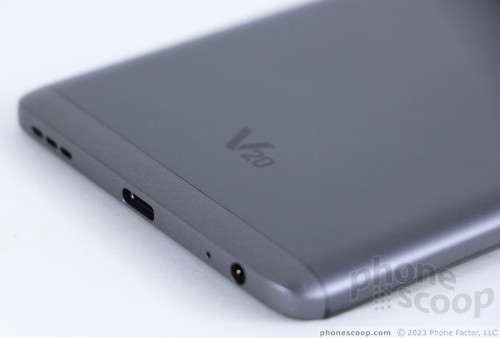
Comments
No messages


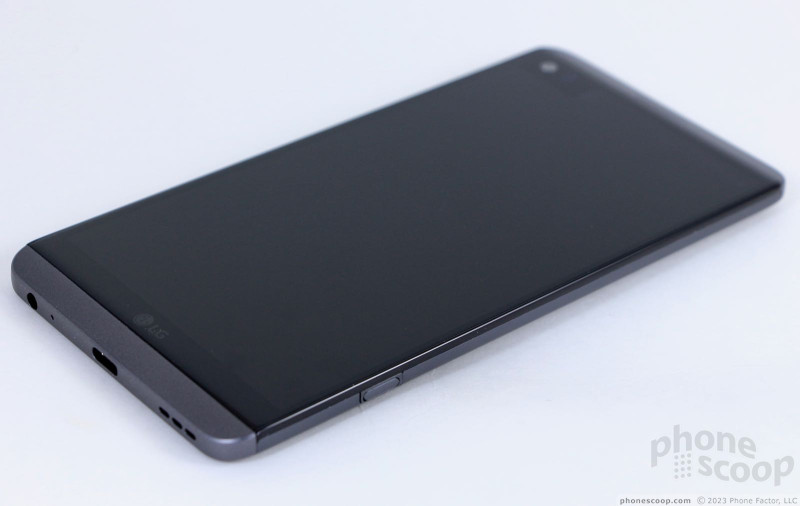















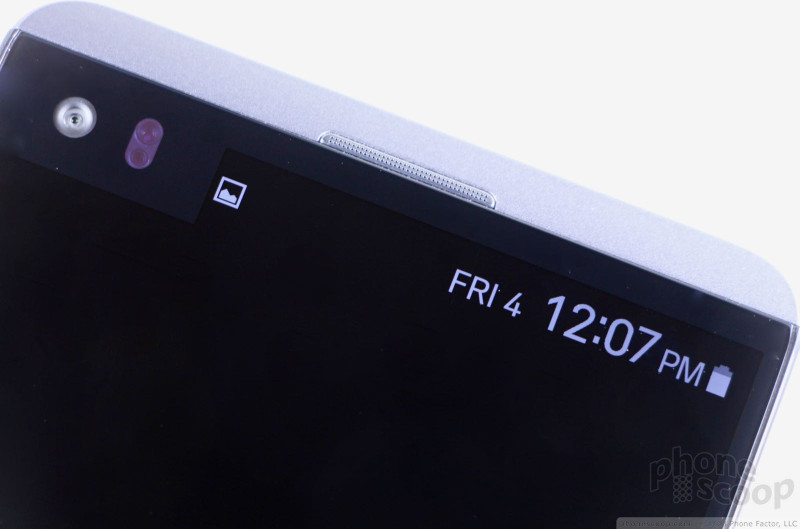



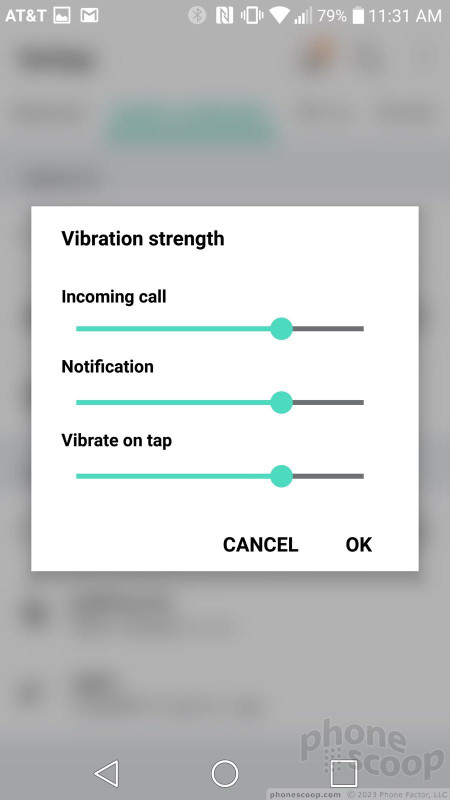


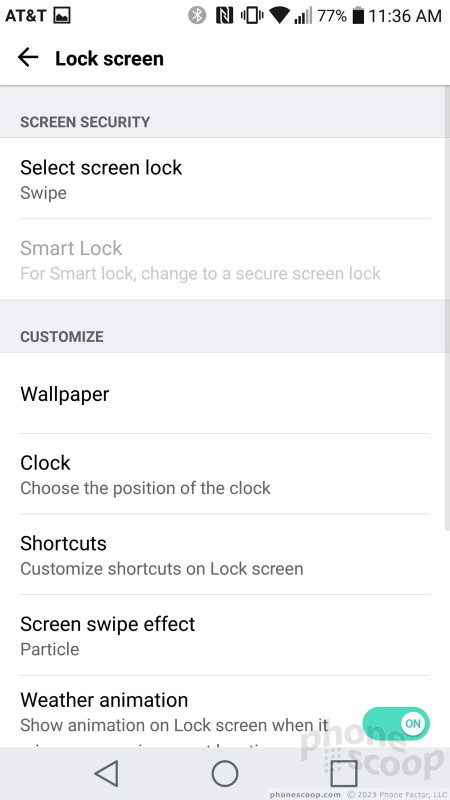






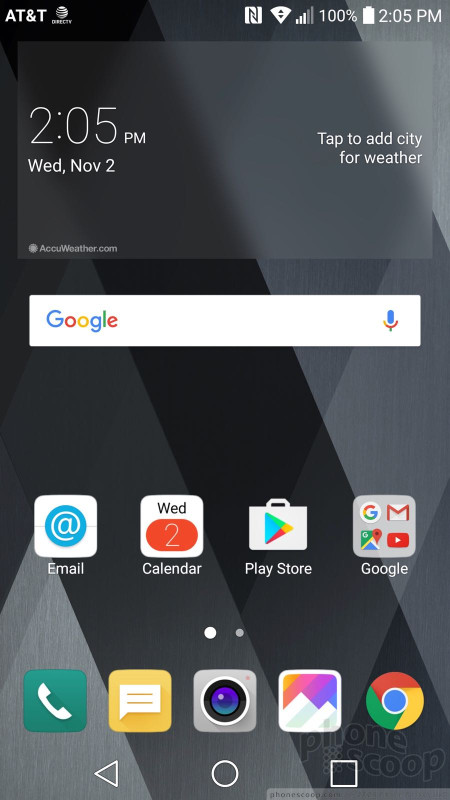







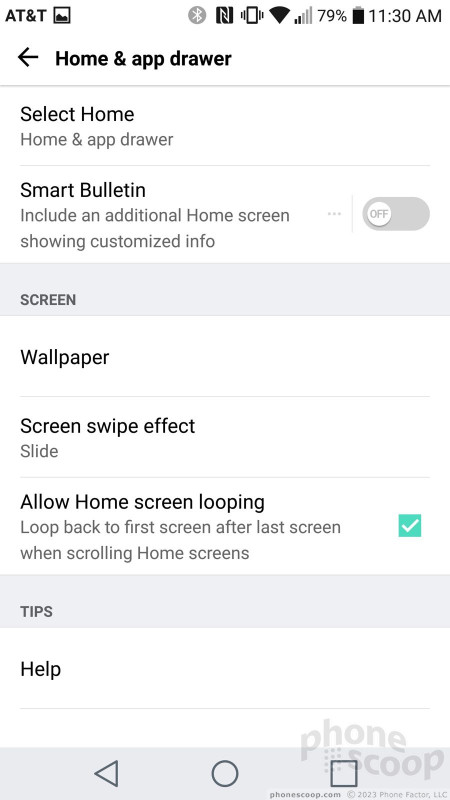








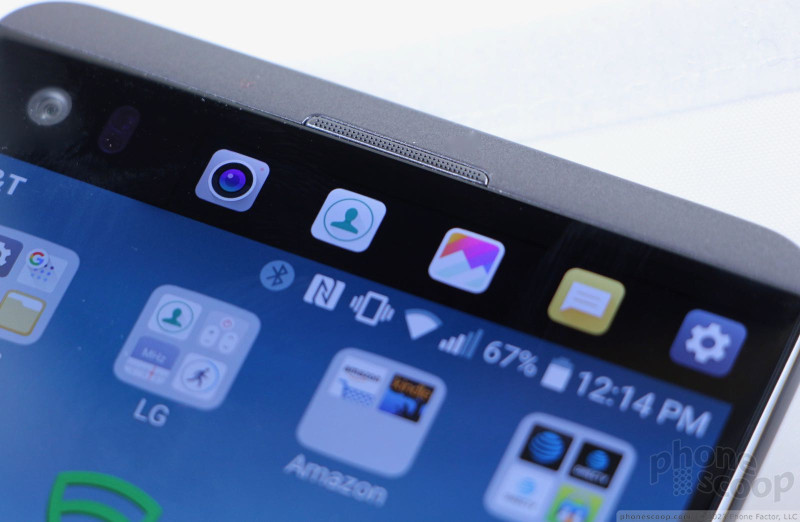




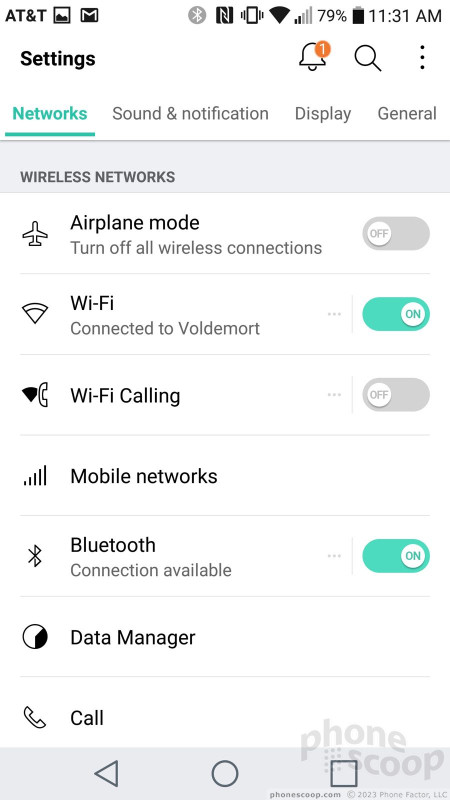










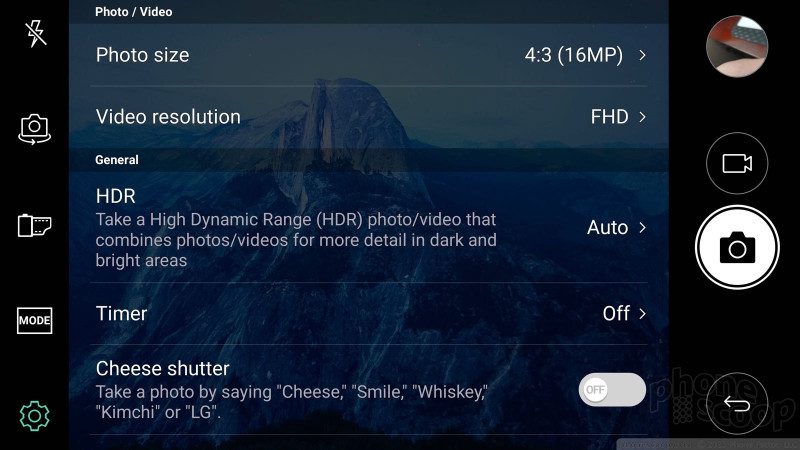





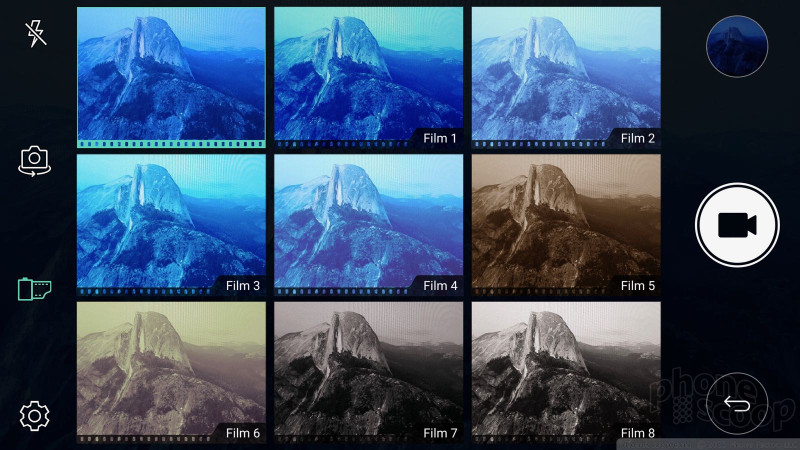





















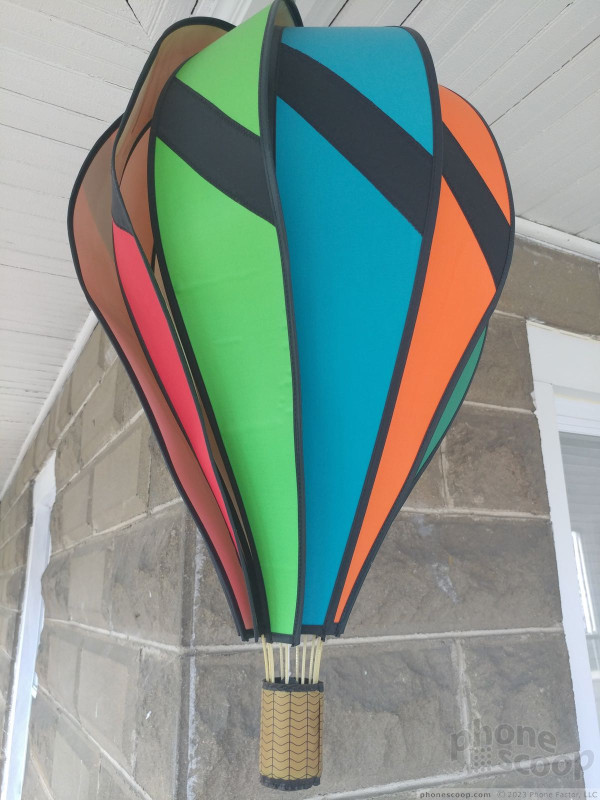








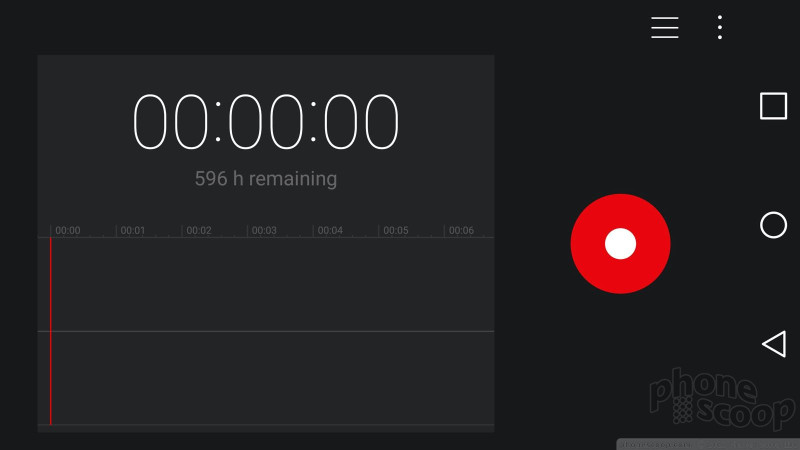





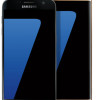 Sprint Flips On 3-Channel Carrier Aggregation for iPhones and Galaxies
Sprint Flips On 3-Channel Carrier Aggregation for iPhones and Galaxies
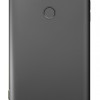 T-Mobile Shares Pricing Details for LG V20
T-Mobile Shares Pricing Details for LG V20
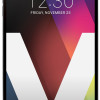 AT&T Shares LG V20 Pricing and Availability
AT&T Shares LG V20 Pricing and Availability
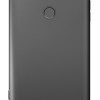 T-Mobile to Sell LG V20 Starting October 28
T-Mobile to Sell LG V20 Starting October 28
 LG Announces the V20 With Android 7, Second Screen, and Dual Cameras
LG Announces the V20 With Android 7, Second Screen, and Dual Cameras
 LG V20
LG V20










